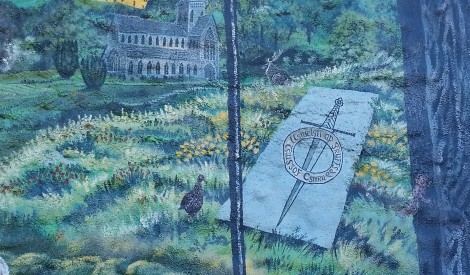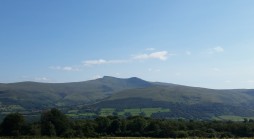It’s a sad fact of life but the most awful things happen at this time of year; at every time of year, truth be told, as I know from the experience of spending most of my adult life working in an A&E unit. This December, in no particular order, we have refugees dying in their attempts to reach Europe; bloody terrorism in Paris and elsewhere; appalling, relentless violence in the Middle East; and closer to home – and maybe not quite so life-shattering but completely miserable to those involved – the floods in Cumbria. There’s nothing I can say about any of this that hasn’t already been said by people more eloquent, informed and useful. My heart goes out to them all. Count your blessings, as my mother used to repeat daily. There’s always someone worse off than you are.
And so in the interests of distraction therapy forgive me if I move to a relatively unimportant snippet of gloom – because it’s over seven hundred years old. As such it’s a bit of an escape (though not for Mr B as I’ve been driving him nuts about it). Anyway, for those of you who don’t know – and probably don’t care, but tough – this past Friday was the anniversary of the slaying of the last true Prince of Wales. Llywelyn ap Gruffydd was killed on 11th December 1282 by Marcher Lords and Anglo-Norman mercenaries acting for Edward I of England, which effectively put an end to the very real possibility of an independent nation of Wales. For some of us (sorry, but there you go) this is the Welsh equivalent of the assassination of John F. Kennedy in terms of conspiracy theory and getting to the bottom of what really happened.
I know – it’s seven hundred and thirty three years. It’s trivial. I’m sad. But this won’t be the last you see of this on these pages, so if it’s a dealbreaker…it was nice knowing you!
The thing is that because we’re talking about an event that took place such a long time ago, there are few real facts to go on. Primary evidence is sparse and what there is – well, history is definitely written by the victors. Which means, of course, that there are lots of stories; nobody knows what is true and what isn’t (and who the hell cares, I hear you ask! Skip to the recipes!).
The most widely held belief is that Llywelyn ventured south from his stronghold in Gwynedd because he thought there was a possibility of an alliance with powerful warlords of the Marches – an alliance which would probably have made all the difference in the war against Edward. Though there is another claim that he was planning on a romantic interlude…come on, really? He’d risk his life and country for a bit of rumpypumpy? I think we can dismiss that one! But whatever the reason for him being in what he knew to be pretty dodgy territory, clearly things didn’t go well and it can’t have been long before he realised his mistake. There is a tale that he got a blacksmith to put his horse’s shoes on back to front in order to confuse the enemy, and that he hid overnight in a cave (there is a cave named for him in the hills above Aberedw, just outside Builth Wells). This is a bit too much like the legend of Robert the Bruce for my liking – though you could argue that there’s no smoke without fire, and why would there be a spot known locally as Llywelyn’s Cave unless this knowledge had been handed down through generations? Mural in Builth Wells showing the myths around Llywelyn’s last day
Mural in Builth Wells showing the myths around Llywelyn’s last day
The precise location of the violence of that day is unknown, just that it occurred somewhere close to Builth. There’s a tradition that the Prince and his companions were killed at Cefn y Bedd, three miles to the west; the village, now known as Cilmeri, is the site of a memorial. The only facts that are reliable are the date (life then revolved around the Church and its calendar – 11th December was the day celebrated as the day of Damasus the Pope, and that year it was a Friday), the weather (there was deep snow on the ground), and that there was a betrayal by person or persons unknown. Though there are plenty of suspects! The end result was that Llywelyn was killed and his army wiped out (apparently the bodies are buried beneath Builth Wells golf course). The Prince himself was decapitated – of course – and his head was displayed on a pike at the Tower of London, where it remained for fifteen years. His body was buried at Abbey Cwmhir, twenty miles or so to the north. There’s a memorial slab there, though the whereabouts of the body are – you’ve guessed it – unknown, probably because the Abbey was severely damaged by Owain Glyndwr in 1402 then fell into ruin after Henry VIII’s dissolution. But there is a statue of Llywelyn in Cardiff’s City Hall – I encourage you all to go and pay homage!

Statue of Llywelyn ap Gruffydd in Cardiff City Hall
 Also from the Builth Wells mural – Abbey Cwmhir and the memorial to Llywelyn
Also from the Builth Wells mural – Abbey Cwmhir and the memorial to Llywelyn
I’m delighted to say that as per the peculiar sense of humour of the Welsh, Llywelyn ap Gruffydd, last Prince of Wales, of the House of Aberffraw, is known as just that… Llywelyn the Last.
And here ends the history lesson for the day – Christmas will return soon, I promise x


I love your history lessons! I have been to Cilmeri and like Glencoe, there is an almost palpable sense of tragedy. Keep the blogs coming – Dal Ati, Mrs B!
just checking